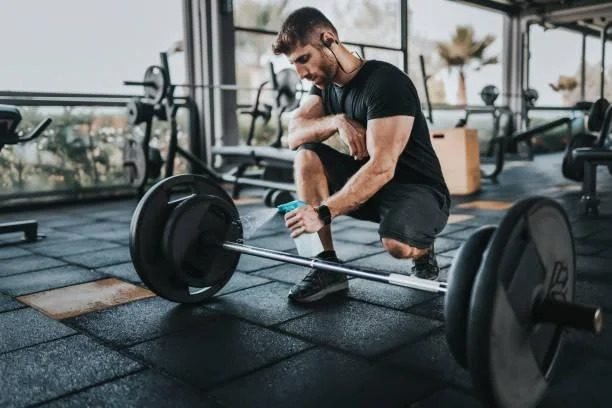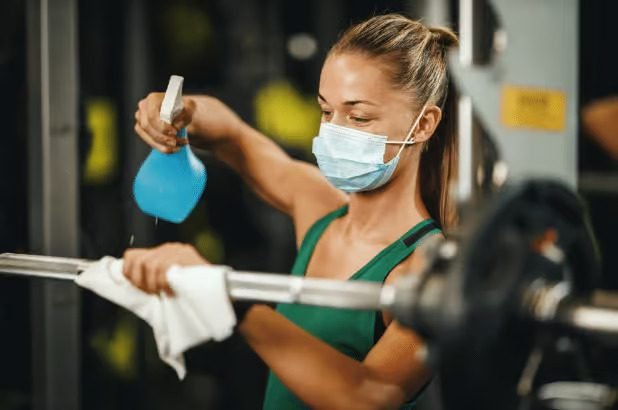Keeping gym equipment clean is essential, not just for hygiene but for the longevity of your gear and the safety of everyone using it. In Santa Rosa gyms, the standards for cleanliness are high, and it’s important to follow best practices to maintain a safe workout environment. This includes wiping down machines after use, sanitizing frequently touched surfaces, and using the right cleaning products. Combat cleaning, a more thorough approach, goes beyond the usual wipe-down, ensuring deep cleaning and disinfection, especially in high-traffic areas. Stay ahead of germs and keep your gym gear in top shape with these simple, effective steps!
Why Cleaning Gym Equipment is Important
Gyms are high-traffic areas, with hundreds or even thousands of people using the equipment each week. From dumbbells and benches to treadmills and stationary bikes, gym equipment is shared by multiple individuals, and with that comes the potential for germs, bacteria, and sweat to accumulate. Cleaning gym equipment helps prevent the spread of illnesses, allergies, and skin infections, while also maintaining the overall condition of the machines.
Additionally, a clean gym makes a positive impression on members. No one wants to work out in a dirty, unhygienic space. A well-maintained gym is not only more appealing to members, but it also promotes an environment where people feel comfortable and motivated to push themselves in their workouts.
1. Wipe Down Machines and Equipment After Use

Wiping down machines and equipment after each use is essential to maintaining a clean and hygienic gym environment. Members should use provided disinfectant wipes or sprays to clean surfaces, focusing on high-touch areas like handles and seats. For deeper cleaning, gyms can hire professional gym cleaning services to perform thorough disinfection, including steam cleaning, upholstery care, and sanitizing high-traffic areas. Regular cleaning ensures a safe and pleasant experience for everyone while extending the life of the equipment.
One of the simplest and most effective ways to maintain cleanliness is for gym-goers to wipe down equipment after each use. Sweat, oils, and germs can quickly accumulate on machines, and wiping them down ensures that the next person using the equipment doesn’t come into contact with these substances.
Most gyms provide disinfectant wipes or sprays for members to use. If you’re a gym-goer, make it a habit to clean the equipment after you’re done. As a gym owner or manager, consider placing cleaning stations near popular machines so that members can easily access disinfecting supplies.
2. Sanitize Frequently-Touched Surfaces
Some gym equipment has specific areas that are touched more frequently than others. For example, on cardio machines, the handlebars are touched often, while on weight machines, the seat adjustments, handles, and armrests are more commonly used.
Make sure these high-touch surfaces are cleaned regularly. It’s also a good idea to keep a schedule for sanitizing these spots throughout the day. This is especially important in a busy gym like those in Santa Rosa, where multiple people may use the same piece of equipment within a short period of time.
3. Combat Cleaning for Deep Clean
Combat cleaning involves a deep clean that goes beyond surface wiping to eliminate hidden germs and bacteria. This includes steam cleaning, using industrial-strength disinfectants, and focusing on hard-to-reach areas. Cleaning of High-touch areas in gyms, such as handles, buttons, and seat adjustments, require frequent cleaning throughout the day. Staff should sanitize these areas regularly, while members can help by wiping down equipment after use. For thorough hygiene, gyms may schedule professional cleaning services to ensure these high-touch spots are consistently disinfected.
While surface cleaning is essential, deeper cleaning, or what’s known as “combat cleaning,” is an effective way to combat the buildup of bacteria and germs over time. Combat cleaning involves a more thorough approach to disinfecting, going beyond the typical wipe-downs.
Combat cleaning can include:
Disinfecting machines with stronger cleaning solutions: Regular cleaning products may not be enough to kill all germs. Use industrial-strength disinfectants designed to kill bacteria and viruses.
Using steam cleaning: Steam cleaning is an effective way to sanitize equipment without using harsh chemicals. It’s also gentle on machines and ensures deep cleaning of hard-to-reach areas.
4. Use Appropriate Cleaning Products
Not all cleaning products are suitable for gym equipment. Harsh chemicals can damage equipment, cause wear and tear, and potentially irritate skin. When selecting cleaning products for gym equipment, consider the following:
Non-toxic and gym-safe disinfectants: Opt for cleaning solutions that are designed specifically for gym equipment. These products are typically non-toxic, safe for use on various surfaces, and will not damage machines over time.
5. Ensure Proper Ventilation
Ventilation plays an important role in maintaining a clean gym environment. Proper airflow helps reduce moisture buildup, which can lead to mold and mildew growth on equipment. Additionally, a well-ventilated gym reduces the smell of sweat and bacteria that tends to linger in high-traffic areas.
Make sure that your gym is equipped with good air circulation systems. Open windows when possible, use fans, and ensure that HVAC systems are maintained regularly. Ventilation not only keeps the air fresh but also reduces the need for excessive cleaning.
6. Focus on Locker Rooms and Showers

While gym equipment is the main focus of cleaning, don’t forget about locker rooms and showers. These areas can accumulate bacteria and germs due to the moisture from sweat and showers. Be sure to clean and disinfect locker room benches, showers, floors, and sinks regularly.
Locker rooms are often where gym-goers experience skin irritations, athlete’s foot, or other hygiene-related issues. By maintaining high standards of cleanliness in these areas, gyms can help prevent such problems and create a more comfortable experience for their members.
7. Regularly Maintain and Clean Air Conditioning Units
In a gym, air conditioning units can gather dust and dirt over time, which can contribute to poor air quality. Make it a point to regularly maintain and clean air conditioning units to ensure that the air stays fresh and free from contaminants.
Air quality is particularly important when it comes to combat cleaning, as poorly maintained air conditioning systems can spread dust, allergens, and bacteria throughout the gym.
8. Clean the Equipment’s Upholstery
Cleaning the upholstery of gym equipment is crucial to prevent the buildup of sweat, oils, and bacteria. Use a fabric-safe cleaner or disinfectant wipes to sanitize the padding regularly, ensuring a fresh and hygienic workout environment. Additionally, Strategies for Cleaning and Disinfecting Gym Saunas and Steam Rooms should be done with specialized disinfectants designed for high-heat environments. Regularly wipe down surfaces, sanitize the floors, and use steam cleaners to kill bacteria and mold, ensuring these areas remain safe and sanitary for all members.
Weight machines, cardio machines, and benches often have upholstery that can harbor sweat, oils, and germs. It’s important to clean the upholstery regularly to prevent bacteria buildup. You can use disinfectant wipes to clean down the surface, but a deeper cleaning may be needed from time to time.
For machines with fabric padding, you may need to use a fabric cleaner to remove stains and odors. Consider using a vacuum or upholstery cleaning attachment to remove dirt and dust from the fabric.
9. Encourage Members to Clean Up After Themselves
One of the simplest ways to maintain a clean gym is by encouraging members to clean up after themselves. Educate gym-goers on the importance of wiping down machines, returning equipment to its proper place, and ensuring that weights and dumbbells are stored correctly after use.
Consider displaying signs that encourage members to take responsibility for cleaning the equipment they use. A gentle reminder goes a long way in ensuring that everyone plays their part in maintaining a clean environment.
10. Hire Professional Cleaners for Deep Clean Days
While regular cleaning can be done by gym staff or members, it’s a good idea to hire professional cleaning services for periodic deep cleanings. Professional cleaners have the tools, expertise, and time to tackle areas that may not be cleaned on a daily basis. This is particularly important for high-traffic gyms or gyms with specialized equipment.
Hiring a cleaning service can help address areas that are often overlooked, such as air ducts, ceilings, or under equipment. A professional team will also use industrial-grade cleaning products that provide a deeper level of sanitization.
FAQs
What is the best way to clean gym equipment?
The best way to clean gym equipment is to wipe down machines and surfaces with a disinfectant wipe or spray after each use, focusing on high-touch areas like handles and seats. Use non-toxic, gym-safe cleaning products to avoid damaging the equipment and ensure hygiene. For deeper cleanliness, incorporate combat cleaning techniques, such as steam cleaning and regular disinfection with industrial-strength solutions, especially in high-traffic areas.
How does a gym maintain standards of cleanliness?
A gym maintains cleanliness standards by regularly wiping down equipment and disinfecting high-touch areas after each use, ensuring a hygienic environment for all members. Staff perform routine deep cleaning, including steam cleaning and sanitizing floors, restrooms, and locker rooms, to prevent germs and bacteria buildup. Additionally, gyms often encourage members to clean equipment after use and may hire professional cleaning services for thorough, periodic maintenance.
What cleaning products do gyms use?
Gyms typically use non-toxic, gym-safe disinfectants that are effective at killing germs and bacteria without damaging equipment. Common cleaning products include multi-surface cleaners, antibacterial sprays, and wipes designed specifically for gym surfaces, including machines, weights, and mats. For deep cleaning, gyms may also use industrial-strength disinfectants, steam cleaners, and upholstery cleaners to maintain a high standard of hygiene.
How often is gym equipment cleaned?
Gym equipment should be wiped down and disinfected after each use to maintain cleanliness and reduce the spread of germs. High-traffic areas and frequently touched surfaces are typically cleaned multiple times throughout the day by staff. Additionally, gyms may schedule deep cleaning sessions, such as weekly or bi-weekly, to thoroughly sanitize equipment, floors, and common areas.
What is the best cleaner for gyms?
The best cleaner for gyms is a non-toxic, EPA-approved disinfectant that is effective at killing bacteria, viruses, and germs while being safe for equipment. Products with antibacterial and antiviral properties, like hydrogen peroxide-based cleaners or quaternary ammonium compounds, are commonly used in gyms. Additionally, gym-safe wipes or sprays that are gentle on surfaces yet tough on dirt and germs help maintain equipment without causing damage.
Conclusion
Cleaning gym equipment should be a top priority for all gyms, particularly those in Santa Rosa where fitness culture is thriving. By following best practices for cleanliness—such as wiping down equipment after use, using the right cleaning products, performing combat cleaning, and ensuring proper ventilation—you can create a safer and more enjoyable environment for gym-goers. Properly maintaining gym equipment and keeping the space hygienic will not only help your equipment last longer but will also foster a positive, healthy atmosphere in your gym.
Remember, cleanliness is not just about keeping your gym looking good; it’s about ensuring the safety and well-being of your members. By taking these steps, gyms in Santa Rosa can provide a space where fitness enthusiasts feel confident, motivated, and ready to take on their next workout!
